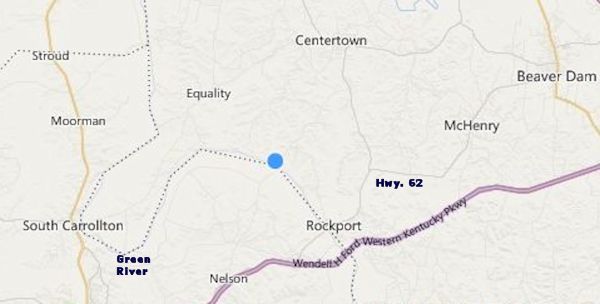Ceralvo, Kentucky-Another Old River Town.
A jrd stat on 10/14/10.
About a hundred miles up the Green River, from the Ohio River, are two small towns.
Not too many years ago, these two towns were on the move and prospering. Rockport
and Ceralvo are two old river towns that have seen better days. At the turn of
the twentieth century, these two towns were in their "Heyday". Rockport had rail
and river traffic and Ceralvo was a busy river town with rail nearby. Wagon trails
serviced both towns, but it would be a few more years before the automobile would
be able to travel, conveniently to these two towns. Only a few miles apart, by
river, these two towns were like sister cities. Each were stopping off points for
river traffic and each town had their own drugstores and doctor's offices. They both
were also "Wild Towns" and the saloons were just a part of each community. Rockport
had a jail. I don't think that Ceralvo did, but I am sure there was a means of
keeping a "Rowdy" drunk contained. Each town was also blessed with churches. As
each town was a river town, each had a ferry and each town had a post office.
Kentucky obtained statehood on June 1, 1792. Rockport was laid out, surveyed and
a plat of the town drawn up in 1860. It was incorporated in 1870. Ceralvo was
laid out, surveyed and a plat of the town drawn up in 1851. It was incorporated
in 1870.
Kentucky, for years and especially in the early years, has been known for the abundance
of wild game and fish. It was also known for the forest that contained countless
hardwood trees and the meadows with deer and elk. The name Kentucky, according to
some, came from an Indian name, Kaintuckee or Cantuckey, meaning "Meadowland".
During prehistoric periods, Indians roamed over much of Kentucky and probably
established permanent settlements within the state. In the mid-seventeen hundreds,
Kentucky was a "Happy Hunting Ground" for the Indians, but no permanent tribe existed
within its' boundaries. The Shawnee, from the North, and the Cherokee, from the
South, used this, soon to be state, as their own personal hunting grounds. By now,
the white man was encroaching on "Indian Land". Daniel Boone, as an explorer, was
the most famous as he and others entered Kentucky from the East and especially
through the Cumberland Gap. Explorers from Pennsylvania and Ohio were coming down
the Ohio River to make their mark on the "Soon-To-Be" state. From the Ohio River,
some of the explorers entered the Green River and headed up river to settle Ceralvo
and Rockport. Of course, the area of Ceralvo, Lewis Creek and Rockport was a good
area to set up base camps and eventually permanent settlements. According to some,
the first settlers were astounded by the great number of deer in this area and
especially the large deer herds that watered and crossed the river as Ceralvo. The
most popular opinion is that Ceralvo was derived from the Spanish word, Ciervo,
meaning deer. Just upriver, the settlement on the bluffs, and the large "outcropping"
of rocks became know as the town of Rockport. Lewis Creek was named after the
family that owned a large portion of land that the creek runs through on its' way
to the Green River.
From the time of incorporation in 1870 until the time frame of the 1937 flood, Ceralvo
was a "Booming" River Town. The natural resources of the area, the abundance of
game and fish, and the river combined to make Ceralvo a prosperous town. Farming,
trapping, hunting, fishing, and logging were just a few of the reasons for Ceralvo's
existence. For a period of more that sixty years, this small river town was a busy
place and a wild place at times. Steamboats were a common site on the river. The
"Showboats" from Evansville made regular excursions to Ceralvo and offloaded passengers
that stayed overnight at the Hotel. These passengers consisted of a mixture of
business people, traders, and party goers. Other types of steamboats, called packet
boats, were used to transport people, mail and goods. These packet boats "Ran"
on a regular schedule. Tobacco, other farm produce, pelts, game, fish, and other
goods were regularly shipped downriver to places like Evansville and St. Louis on
these packet boats. The incoming packet boats brought the necessary goods for the
Ceralvo area residents.
Now, some one hundred and fifty years later, the world has not been that kind to
Ceralvo. At the time of this writing, a weather-beaten church, a cemetery and a
few houses remain. The Church and the cemetery are still open for business and
probably the few citizens left do not want their secret broadcasted about being a
fabulous place to live and the peace and tranquility of being next to Green River
every day. May the residents continue to populate this small town.
:>)

